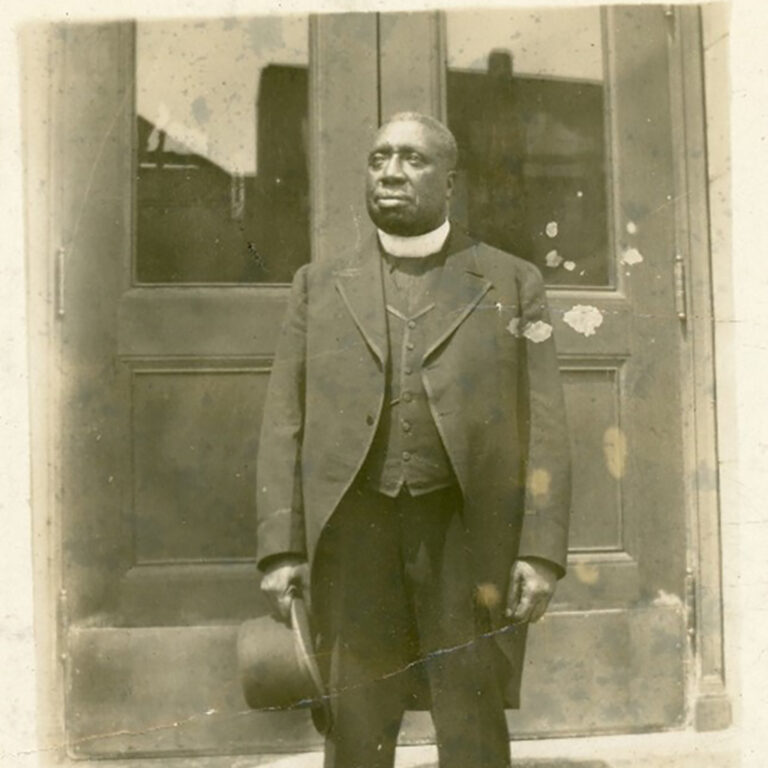Black History Month Spotlight: William Tecumpseh Vernon
By Kate Sutter
NEWS — February 1, 2023

Bishop William Tecumseh Vernon was born to emancipated parents in Lebanon, MO in 1871. His father Adam took their name from his enslaver, a military officer who served with Andrew Jackson at the Battle of New Orleans, moved to the Missouri after taking Cherokee to Indian Territory in the 1830s, and died in a federal prison camp after taking Adam to serve with him under Confederate General Price. After becoming a freedman, Adam’s son, William Tecumseh, was born.
W.T. Vernon’s distinguished professional career in education and political activism began as the 1890 valedictorian of Lincoln Institute (now University) in Jefferson City, MO. His career in educational leadership spanned from being the teacher and principal of Sumner Elementary in Lebanon to president of Western University in Quindaro, KS. Segregated schools in both places would later be named for him, including the Vernon Multipurpose Center in North Kansas City. Following in his father’s footsteps, he was ordained in the AME Church in 1896 after obtaining a divinity degree from Wilberforce in Ohio.
Well-regarded as a gifted orator, his promotion of Black rights saw him travel literally around the world. He is listed as a speaker at the 1894 “Emancipation Day” celebration in Lebanon, a meeting of the typically segregated Kansas Day Club in Topeka, and later, the NAACP’s 1923 National Convention in Kansas City. At just 25 years of age, he became president of Western University and would be sent to South Africa before returning to Quindaro at the end of his career. Locally, he was known a politically active Republican and supported William Stanley’s successful campaign for Kansas governor in 1898. His support was rewarded when Stanley helped Western University receive $10,000 from the state legislature. During this first stint at Western, his advocacy of Booker T. Washington’s philosophy became evident. He helped start industrial and vocational education programs and even brought Washington to speak to students in 1906.
Perhaps most significantly, President Theodore Roosevelt appointed him as the U.S. Treasurer. He was then re-appointed under Roosevelt’s successor, William Howard Taft. At the time, this was the highest federal office ever held by a Black man, and his signature is printed on all US currency minted from June 1906 to March 1911.
Vernon left Washington DC in 1912 after the election of Democrat Woodrow Wilson, and in 1920 he became Bishop of the AME church in South Africa, where he traveled to and ministered for 4 years. Reflecting his two passions, Vernon established churches and schools in South Africa, including one named for his wife Emily in what is now Lesotho. In 1932, after a change in the structure and leadership affecting the AME church and allegations of serious moral and financial concerns, Vernon and two other bishops were expelled from the denomination. Despite the objections of church leadership who subsequently withdrew their affiliation with Western, Kansas governor Alf Landon returned him to the university to lead its industrial programs. He retired in 1936 and later passed in 1944, 72 hours before his wife.
Sources:
https://ffnha.oncell.com/en/western-university-310078.html
https://www.blackpast.org/african-american-history/vernon-william-tecumseh-1871-1944/
https://kcblackhistory.org/articles/william-t-vernon
https://www.findagrave.com/memorial/53740213/william-tecumseh-vernon
https://www.kshs.org/kansapedia/william-t-vernon/12230
https://digital.ncdcr.gov/digital/collection/p249901coll37/id/4570
https://www.republic-online.com/opinion/columns/bishop-w-t-vernon-and-his-thoughts-on-john-brown/article_8ac9381e-d53e-11ea-8914-9be07dbf25a4.html
14th Annual Report of the National Association for the Advancement of Colored People, pg 38
https://en.wikipedia.org/wiki/William_Tecumseh_Vernon
Hart, Joan Rowden. “Why We Honor William Tecumseh Vernon.” Lebanon Daily Record, 19 Apr. 2016.
https://www.flickr.com/photos/washington_area_spark/38612867480
https://archives.lib.ku.edu/agents/people/5634
Wenske, Paul. “Western University at Quindaro and Its Legacy of Music.” Kansas History: A Journal of the Central Plains, vol. 42, no. 2, 2019, pp. 115-123., Accessed 2 Feb. 2023 at https://www.kshs.org/publicat/history/2019summer_wenske.pdf
Lee, Davis. “Claim A. M. E. Bishop Guilty Of Raping Wester U. Co-Ed.” Indianapolis Recorder, 3 Aug. 1935, p. 16. Accessed 2 Feb. 2023 at https://newspapers.library.in.gov/?a=d&d=INR19350803-01.1.16&e=——-en-20–1– txt-txIN——-
Engel, Elisabeth. “Southern Looks? A History of African American Missionary Photography of Africa, 1890s–1930s.” Journal of American Studies, vol. 52, no. 2, 4 May 2018, pp. 390– 417., https://doi.org/10.1017/s002187581700192x.
https://youtu.be/gMEw-kiF_sY Min 11:17-15:20
Freedom’s Frontier National Heritage Area (FFNHA) is dedicated to building awareness of the struggles for freedom in western Missouri and eastern Kansas. Its themes are the settlement of the frontier, the Missouri-Kansas Border War and Civil War, and the enduring struggle for freedom. These diverse, interwoven, and nationally important stories grew from a unique physical and cultural landscape. FFNHA inspires respect for multiple perspectives and empowers residents to preserve and share these stories. We achieve our goals through interpretation, preservation, conservation, and education for all residents and visitors.
-###-
CONTACT:
Lucinda Adams
Executive Director
Freedom’s Frontier National Heritage Area
[email protected]
785.424.5851
news-advocacy
news-advocacy
